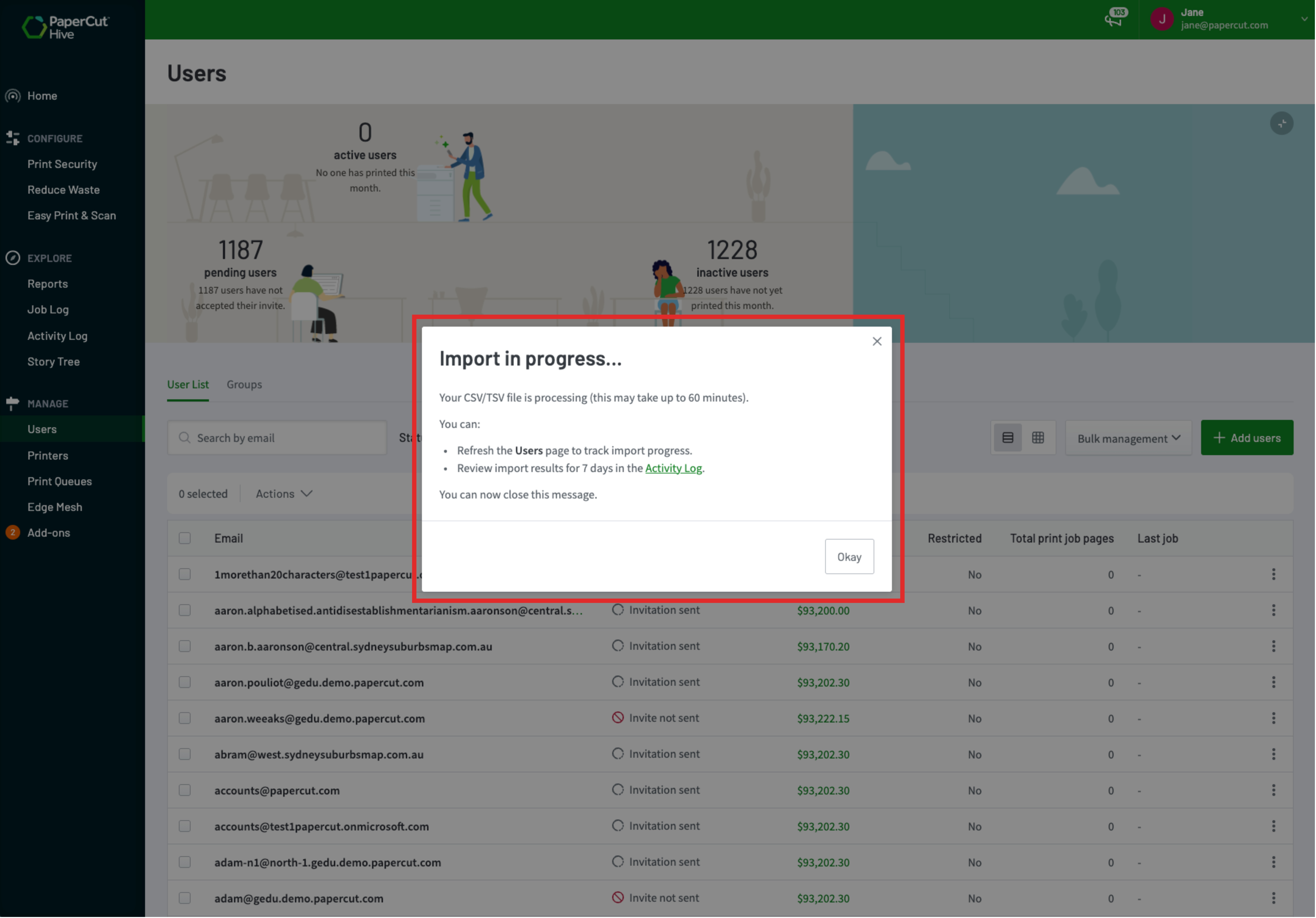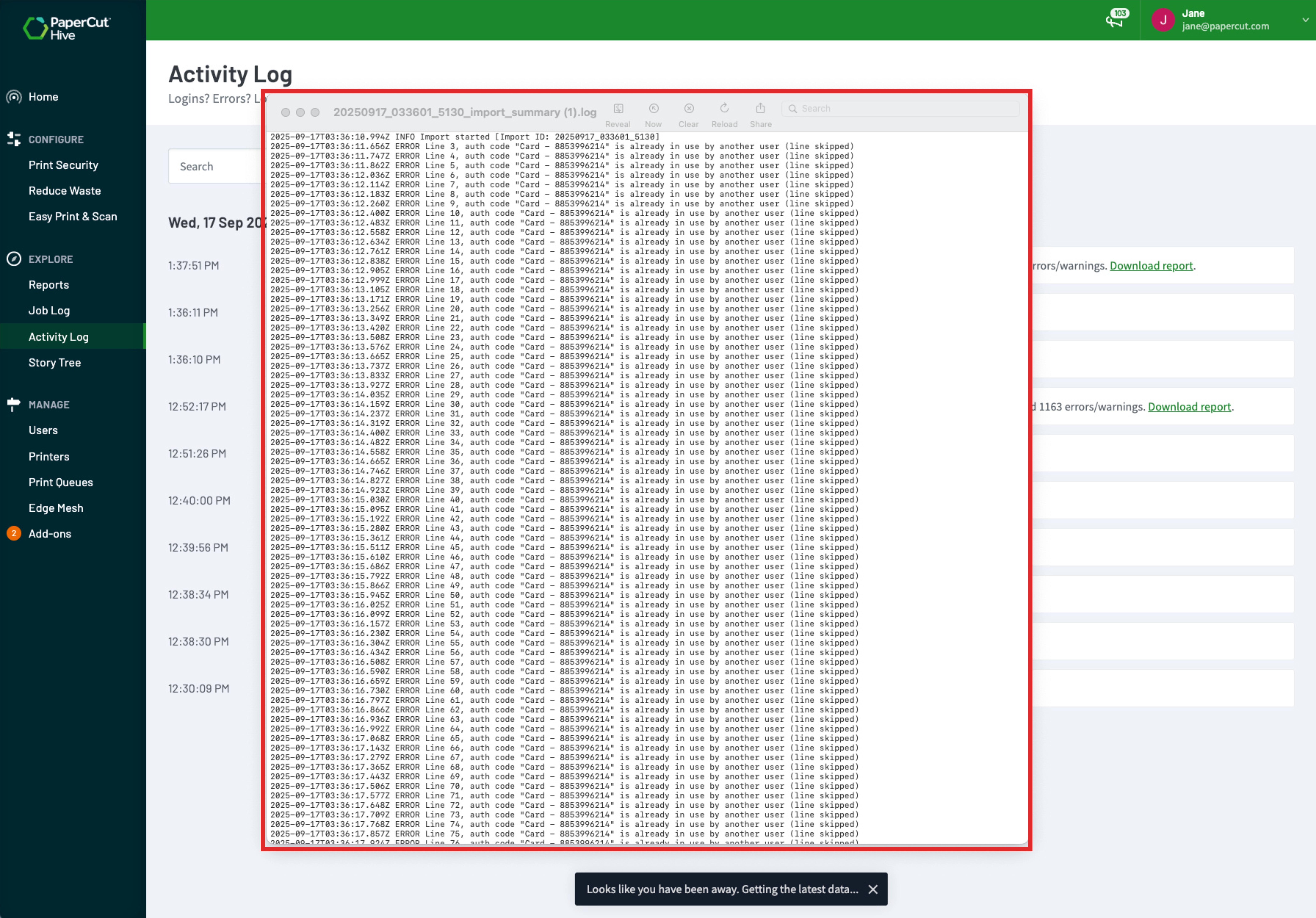Overview
The User Data Import Tool is a new, built-in feature in PaperCut Hive and Pocket designed to help admins and resellers easily import user data, particularly during migrations from PaperCut NG/MF or other systems. This tool gives admins greater control and visibility when adding and updating users, reducing setup time and improving accuracy during onboarding.
Key benefits
- Streamlines Migrations. It simplifies the process of migrating users from another print management solution or from PaperCut NG/MF. This helps admins and resellers confidently move customers to Hive with a much smoother process.
- Simplifies Onboarding. The tool provides a simple, flexible way to bulk import key user data like email addresses, user balances, card numbers, and access codes. This is particularly useful for new customers who can use their preferred IdP (Identity provider) add-on and use the CSV importer to fill any gaps in their user data.
- Saves Time and Reduces Errors. It eliminates the need for manual data entry, allowing admins to import or update hundreds of users in minutes instead of hours.
- Ensures a Smooth Start for Users. The tool ensures that users can start printing right away with their existing cards, which reduces complaints and confusion. This means a better user experience and less support load on admins and resellers from day one.
Deeper details
We know that setting up a new organization isn’t always as simple as it should be. The challenge is getting user data like card numbers and balances into Hive to be ready for users to print. A common problem is when an IdP add-on doesn’t sync all the required user information, forcing customers to make a difficult choice between essential features. For instance, customers using Microsoft Entra ID may have to choose between an add-on that supports user deletions and one that supports card numbers.
The User Data Import Tool is the solution to these pain points, allowing you to bulk import user details via a simple spreadsheet.
How it works:
- The User Data Import tool accepts both CSV and TSV file formats.
- It supports files up to 65MB.
- It uses the user’s email address as the unique identifier and can either create a new user or update an existing one.
To get started;
- Use our downloadable CSV template (for customers importing user data from systems other than MF/NG)
- Export your existing PaperCut Hive user list (existing PaperCut Hive customers)
- or export the user list from MF/NG (PaperCut MF/NG customers migrating to paperCut Hive)

The tool can import a variety of user data, including:
- Email (Required)
- Full Name, Access Codes, and up to 5 Card Numbers (Optional)
- Balance and Restricted status (Optional)
- Some data from PaperCut NG/MF, such as “Department” and “Office”, will be imported and stored, but is not currently used within Hive’s interface.
Here’s what’s important to know:
- We recommend a “test” processing option first, which is a dry run that checks for errors without making any permanent changes.
- If your CSV file contains new users, and you select the Create new users and update existing users option, new users will be created.
- If your CSV file contains new users, and you select an invitation type to send to new users, new users will be invited.
- The data in your CSV file’s columns will be imported against the respective user records, overwriting any existing data in the user records.
- Access Code Notifications: We are making enhancements to this feature to give you more control over your rollout. We are adding controls to disable the automatic notification emails that are currently sent when new access codes are imported, giving you flexibility for staged rollouts.
- After you start the import, you cannot stop it or undo it. The import runs in the background — you don’t need to keep PaperCut Hive or Pocket open.
- When the import is complete, a report is available in the Activity Log for up to 7 days.
Best Practices to Prevent Issues
- Export a baseline user list before making changes.
- Test with a small sample file (e.g. 10 users) before running a large import.
- Avoid unnecessary columns to speed up processing and reduces errors.
- Schedule imports during off-peak hours to avoid disruption.
- Validate a few users post-import (log in, print/scan, access card check).
How to configure:
The process is designed to be straightforward and give you full control.
1: Prepare Your CSV or TSV File
Use a blank CSV file, export the file from PaperCut Hive or use a file exported from another system, including PaperCut NG/MF and make changes to your user data as required.
- Encoding: Ensure file is saved as UTF-8; other encodings (e.g. ANSI) may cause corrupted data.
- File size: Must be <65MB.
- Column names: Must exactly match Hive’s field names (in English).
- Missing “Email” column: File will be rejected, as email is mandatory.
- Multiple rows per user: If the user data import tool identifies a single user as having multiple rows, the import will fail. Each user (determined by unique email address) must only have a single line/row. If sequential data operations are required, split these into different CSV files, and upload them in the appropriate order.

.jpg)
2: Dry Run
We recommend running a test first. This is a simulation of the import that checks for errors without making any permanent changes to your organization. Check the activity log when your test is complete.
The Activity Log results for the test or import contains details on:
- how many rows have been processed
- how many users were created
- how many users were updated, and
- any rows with errors that were not processed, and the reason why.


3: Import
Once you’re confident in your file, you can run the import.
The tool will either create new users or update existing ones. When creating new users select the method for inviting them to PaperCut Hive.
The import process is irreversible, so the dry run step is key.


4: Review Results
After the import is complete, you can check the Activity Log to see how many users were created, updated, and if there were any errors.

Example use cases and outcomes
Seamless Migration from PaperCut MF or any other print management platform to PaperCut Hive
You’re an existing PaperCut NG/MF customer setting up PaperCut Hive. You can export your user list from MF, and use the import tool to quickly get all users including their current balances and card numbers, into Hive, making the transition effortless.
Onboarding a new organization without an IdP
You’re setting up a brand-new Hive organization that doesn’t use a supported IdP. Simply use our CSV template to create all your users in minutes.
Updating data for an existing organization
You’re an existing Hive customer and your organization is updating its security card system. Use the Import User Data Tool to quickly bulk update all your users’ new card numbers, ensuring they can keep printing without interruption.


